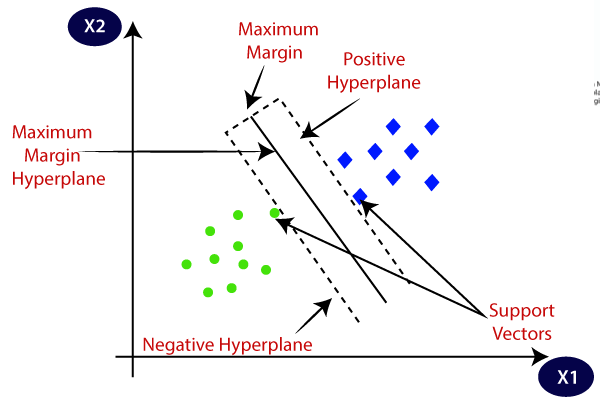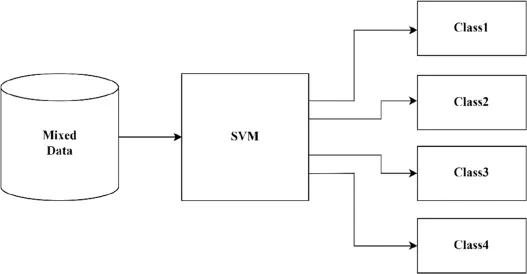Understanding Support Vector Machine Algorithm
SVM full form is Support Vector Machine is a supervised machine learning algorithm that is used for classification and regression analysis. Support Vector Machines (SVM) is a branch of artificial intelligence. It is a binary classifier that finds a hyperplane that separates two classes of data points in the best possible way. It was first launched by Vapnik and his colleagues in 1992. The algorithm is based on the idea of finding the optimal hyperplane that separates the data points of different classes.
The hyperplane is selected in such a way that the margin between the hyperplane and the closest data points of each class is maximized. The data points located nearest to the hyperplane are technically known as support vectors, thus providing a hint at how the term was derived. Support Vector Machines can work with both linear and non-linear data and can handle high-dimensional data with ease. The objective of SVM is to find the best hyperplane that maximizes the margin between the two classes of data points. APKShoot will explore SVM, its classification and regression analysis. Also its application in fields, including image classification, text classification, and bioinformatics

Working of SVM
SVM works by transforming the input data into a high-dimensional space, where the data can be separated by a hyperplane. The hyperplane is defined as w*x + b = 0, where w is the weight vector, x is the input vector, and b is the bias. The goal of the algorithm is to find the values of w and b that maximize the margin between the hyperplane and the support vectors.
To find the optimal hyperplane, it uses a kernel function that maps the input data into a high-dimensional feature space. The most commonly utilized kernel processes are linear, polynomial and radial basis function (RBF) kernels. Once the data is transformed into a high-dimensional feature space, Support Vector Machine finds the hyperplane that separates the data points of different classes with the maximum margin.
To understand how SVM works, let’s consider an example of binary classification. Assume we have two different classes of data points: blue and parrot green. We want to find a hyperplane that separates these two classes in the best possible way. The hyperplane that maximizes the margin between the two classes of data points is the optimal hyperplane.
Support Vector Machine works by transforming the input data points into a higher-dimensional space where they can be separated by a hyperplane. This phenomenon is called the kernel trick. The support Vector Machine then finds the hyperplane that maximizes the margin between the two classes of data points in this higher-dimensional space. The data points nearest to the hyperplane are termed support vectors, whose purpose is to identify the positioning of the hyperplane.

Different SVMs
Support Vector Machine comes in two varieties:
1. Linear Support Vector Machine
Linear Support Vector Machine is used for data that can be divided into two classes using a single straight line. This type of data is called linearly separable data, and the classifier used is known as a Linear SVM classifier.
2. Non-linear Support Vector Machine
Non-Linear Support Vector Machine is used for non-linearly separated data. If a dataset cannot be arranged using a straight line, it is supposed non-linear data, and the classifier implemented is referred to as a Non-linear SVM classifier.

Applications of SVM
Support Vector Machine has a wide range of applications in various fields, including:
- Addressing the geo-sounding problem
Support Vector Machines are used to track the layer structure of the planet, linear functions and support vector methods are used to separate electromagnetic data and inversion issues are solved to account for the variables that generated the observations.
- Assessing seismic liquefaction potential
SVMs are essential for handling two tests (SPT and CPT) to determine seismic status, calculate the likelihood of soil liquefaction, and create models with numerous variables to calculate ground surface strength with close to 96-97% accuracy.
- Protein remote homology detection
SVM in computational biology is important for protein remote homology. It helps to classify proteins according to their sequence and utilizes kernel functions to find similarities between sequences.
- Data classification
The Newton-Armijo algorithm is used to handle larger datasets, and smooth Support Vector Machines with smoothing techniques that eliminate outliers are chosen for data classification. Strong convexity is also explored for non-linear data, as well as other mathematical features.
- Facial Detection & expression classification
Support Vector Machines are used for facial detection and expression classification, differentiating between facial and non-facial structures and classifying expressions like happy, sad, angry, and surprised.
- Surface texture classification
SVMs are used to classify surface texture in images, differentiating between smooth and gritty surfaces.
- Text categorization & handwriting recognition
SVMs are used for text categorization, transferring scores to articles and documents and classifying them into predefined categories. Support Vector Machines are also used for handwriting recognition and segregation by humans and computers.
- Speech recognition
Support Vector Machines are used for speech recognition, extracting features from words and training models for speech recognition.
- Stenography detection
Support Vector Machines can be used to detect tampering in digital images, isolating pixels and analyzing them in different datasets to spot hidden or watermarked messages.
- Cancer detection
SVMs can be used in cancer detection, analyzing images of cancerous tissue and categorizing them as benign or malignant.
Advantages of SVM
SVM has several advantages over other machine learning algorithms, including:
- Effective in high-dimensional spaces
- Amazing performance even when there are more features than samples.
- It is applicable to outlier detection, regression, and classification.
- Suitable for situations where the number of dimensions exceeds the number of samples
- The algorithm can implicitly map the data into a higher-dimensional space thanks to the kernel approach.
- With both linear and non-linear data, it performs well.
- High-dimensional data may be handled easily by it.
- It is a strong algorithm that can deal with erratic data.
- It is simple to comprehend and apply since it has a solid theoretical base.
- Both classification and regression functions can be achieved with it.
Disadvantages of SVM
Despite its many advantages, Support Vector Machine also has some limitations, including:
- Choosing the appropriate kernel function can be challenging
- Responsiveness to the selection of kernel function parameters
- Memory-intensive: requires a large amount of memory to store the support vectors
- Computationally intensive: requires a lot of computational power to train the algorithm on large datasets
Conclusion
To sum up, Support Vector Machine is a potent machine learning technique used for regression and classification. It operates by locating the ideal hyperplane that divides the data points into various classes. SVM has several uses in a variety of industries, including speech recognition, text classification, bioinformatics, and image classification. In comparison to other machine learning methods, it has a number of benefits, including its versatility and efficiency in high-dimensional areas. It also has several drawbacks, such as high computational and memory demands and sensitivity to the selection of kernel function parameters.
Related Articles
- The Future of Artificial Intelligence
- A Guide to Deep Learning
- Chatbots Software for Small Businesses
FAQ
There are several types of SVM kernels, including linear, polynomial, radial basis function (RBF), and sigmoid.
No, SVM is a supervised learning algorithm and cannot be used for unsupervised learning.
SVM is a binary classifier that finds a hyperplane that separates two classes of data points in the best possible way, while logistic regression is a probabilistic classifier that estimates the probability of an input belonging to a certain class.










